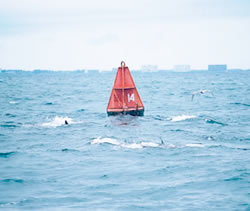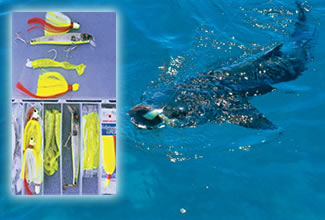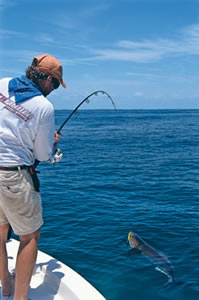September 01, 2011
By Mark Hatley
You'll find cobia and manta rays attracted to plankton-fish color changes.

Motoring up on a scenario like this, manta rays feeding on the surface near a marker buoy, almost guarantees you'll be casting at cobia.
|
Frustration was starting to set in. We'd been running from thunderstorms all morning, and were now caught just off the beach between two large systems—one to the south and one to the north. To make matters worse, it was nearly 10 a.m., and despite some serious searching, we hadn't caught a single baitfish.
Pinned between two storms my options were to wait it out where we were or run east in hopes of finding something to fill the livewell. I opted to continue the hunt for bait.
Advertisement
Three miles off the beach the water turned from a milky green to a clear blue and the current was honking, pushing the two water densities against each other and creating a well-defined edge that was littered with small clumps of sargassum. Periodically, Spanish sardines flicked across the surface of the colored edge.
“We're in there,” I told my fishing partner. “All the bait must be stacked along this edge eating the food pushed up by the colliding currents.”
Advertisement
Our sabiki rigs were filled on every drop and the livewell started to look like a small aquarium when Tom pointed out a pair of fins moving directly toward the boat.
“Are those sharks?” he asked, pointing toward the fins with his rod.
The triangular fins bobbed up and down in the waves, and then one flashed white.
“Manta ray,” I replied. “Those are its wing tips. The white is its underside.”
The immense ray glided by the boat hugging the clear blue side of the color change, obviously taking advantage of the concentration of plankton brought to the surface by the currents. Oddly, the big ray had its entire body on the surface, and kept poking its face in the air so that its mouth could filter the top six inches of the water column. Even in the gray light we could see the brown shapes holding under the ray as it passed just a few yards from the boat.
“Cobia!” I shouted. “Grab your spinning rod.”
Even when specifically targeting cobia, the sight of a half-dozen 30- to 50-pound fish hugging the underside of a ray will throw a little adrenaline boost into most anglers, and by the time Tom had a sardine on his rod he also had the rig on his sabiki rod firmly attached to his pants cuff and both his shoes.
I freed him with surprisingly minimal effort, and we eased the boat up the color change to the ray. When the sardine hit the water, all six fish raced for it. A 35-pounder sucked it in and turned to rejoin the ray.
Tom set the hook, which stopped the cobia in its tracks where it violently shook its head while Tom struck again, sending the fish diving for the bottom. On 12-pound tackle the fish took around a half hour to land, and while we fought to regain 50 yards of line manta rays started popping up along the color change in ever-increasing numbers. By the time we threw the cobia into the fish bag, we could see over 20 of the big rays surface-feeding along the blue edge.
It was obvious that the color change is what drew those manta rays, as each ray worked the surface layer within 100 yards of the well-defined edge. All the fish were skimming the surface with their mouths puffed out in a giant oval plankton sieve. But it's not only the deepwater color changes that attract rays.
On a regular basis I've found manta rays swimming along the tidelines off the St. Lucie, Fort Pierce and Jupiter inlets. In these areas, the outgoing tide brings discolored, often brackish water out the inlets where it meets ocean tidal currents, creating a definitive color change. Here the rays don't skim the surface like the fish we found offshore last May; instead, the rays swim down two or three feet, along the clean side of the edge. As with the offshore fish, these rays have their mouths stretched out to the point that it's obvious they're straining plankton.

Cobia hit a variety of lures; shock leader protects against line chafing on the fish's rough mouth.
|
The rays that run the inlet color changes usually aren't the immense, mature fish with the 10- to 12-foot wingspans you'll find offshore, but they're certainly large enough to hold a cobia or two. And with the smaller rays the cobia can't tuck up under the wings where they're difficult to spot.

Polarized sunglasses help for spotting mantas, below, and presenting baits to cobia.
|
Tidelines are particularly effective in the spring and early summer, when the first rains are washing fresh water out the inlets. The best lines form around stronger than normal tides, as during new and full moons.
Because tideline rays are actively feeding, they usually won't spook from a boat. Offshore, rays often dive at the sound of an approaching boat; out here you have to determine in which direction they're swimming, then either creep up from behind, or run ahead and shut down in the fish's path and wait for it to come to the boat.
In either instance, you need to be ready with a lure or bait. The first encounter offers the best chance at a hookup. The fish are naturally curious, and probably deem the boat as a larger rendition of the swimming food processor they've been shadowing for the last few days.
One of the best lures to throw at approaching cobia is a chartreuse jig. It doesn't matter if it's a plastic, swimming-tail jig, a feather jig or the chartreuse version of the Red Tail Hawk jig commonly used in snook fishing. The color and action of the jig will immediately draw the cobia's attention. I make sure I have at least one rod rigged with this lure before I leave the inlet.
Swimming plugs are another good option, but multiple hooks are somewhat hazardous when you toss a fish into the boat. Again, chartreuse is the color of choice, with floating/diving plugs that can be retrieved with a side-to-side swagger favored over sinking plugs.
Of live baits, given a choice I'd take a Spanish sardine over any of the whitebait species, but threadfin herring, cigar minnows and scaled sardines work just as effectively.
I carry live shrimp in one of my livewells on a regular basis during the spring and they're outstanding for cobia. A lot of times the shrimp are too small to cast any distance, so I'll tie on a 1⁄4- or 3⁄8-ounce jighead and hook the shrimp upwards through the mouth. The same goes for fishing live crabs, another good bait. Add a jighead to the crab and you double your casting distance.
On the color changes there isn't much structure for the fish to break off on, so you can use 12- to 20-pound tackle. The lighter gear allows for longer, more accurate casting with lighter lures and baits. The only requirement is that reels hold at least 200 yards of line, in case a fish makes a long run before you can follow with the boat.
Cobia don't have much in the way of teeth, but I like a 24-inch section of 50-pound fluorocarbon leader. Last June, I had an angler hook an 82-pound cobia that took him an hour and 40 minutes to land. He fought the fish on 20-pound gear and it spent enough time alternating from hugging the bottom and swimming under the boat that we finally landed it more than two miles from where it was hooked. During the course of the battle and when swinging the gaff, we found extra comfort knowing we had that heavier leader.
Besides the normal color changes created where currents meet, there are color changes made when waters of different temperatures collide. We see these during the summer when coldwater inversions push icy-cold water out of the offshore depths. The colder water is denser and heavier than warm water, so it stays down deep while the warmer water remains on the surface.
Rays react to the chill by moving to the surface for warmth. The coldwater inversions are often marked by cloudy green water. The cold water can range for miles, but where it meets the normal warm ocean water there's a distinct color and temperature change, and the rays congregate at these areas.
These inversions can take place any time of the year, but consistently occur around the lobster season in late July and early August, when the cobia have migrated north. Still, there's enough resident cobia to make hunting these color changes for rays worthwhile.
Follow a color change for several miles while scanning for rays; if you don't find them, it's best to move on to other locations. If you encounter a ray or two while searching a color change, then that's a good sign that the fish are feeding along that edge and it's worth the effort to put in an extra few miles.
Where and When
From Palm Beach to Sebastian Inlet, cobia can be caught every month of the year, but there are times when the fish move through in large schools. These fisheries are consistent enough to label as migrations, although wind and weather patterns may shorten or delay the movements.
February is the month when the largest concentrations of cobia pass through the Space, Treasure and Gold Coasts. The fish show on the northern end of this range early in the month, and work their way south, typically being encountered north of Fort Pierce somewhere around Valentine’s Day. By mid-March the fish are somewhere between the St. Lucie and Jupiter inlets, and out of range by the end of March.
These winter fish are the largest cobia of the year, and they move through the area the same time as sailfish. Just days into 2006, January anglers found spectacular manta ray schools and attendant cobia offshore. Both stick close to the immense bait concentrations that occur at the same time of year, and it’s not uncommon to follow a multiple hookup of sailfish with a multiple hookup of cobia or vice versa.
The same type of migration takes place in May, only from south to north and at a much faster pace as the fish ride the swift Gulf Stream currents. Though smaller than the fish that passed through only a few months prior, they can be encountered in huge schools. The fish that show in early May off Palm Beach can move all the way up to Cape Canaveral in a few weeks, so the run can be short-lived.
There are also schools that are late migrating north, and these can be found from Father’s Day all the way into late July. This group of fish is smaller in size and numbers, and they are inconsistent, gathering on the rays in good numbers one day, and gone for good the next. For this reason, when you hear about a cobia bite in the summer months it pays to take action right away or the only cobia on your dinner table will come from the buddy who told you about the bite.
More about Manta's
Unlike many ray species that are bottom feeders that eat mostly fish and shrimp, the Atlantic manta ray is a filter-type feeder that relies primarily on zooplankton, although they will also ingest shrimp and small finfish. They use the large protrusions on their heads (called cephalic lobes) to form a circular, funnel-like enclosure that channels food into their mouths.
Often solitary, mantas aggregate during the mating season which begins in late December and lasts through spring. During the spawning months they can be seen leaping out of the water or doing back flips; this behavior may be part of the mating ritual or an attempt to shake loose parasites.
Manta rays are ocean pelagics that inhabit nearshore and offshore coastal waters usually less than 200 feet in depth, but have been encountered 20 miles or more offshore. They favor the waters closer to shore and spend a large portion of their lives near the surface, particularly in areas where food is pushed to the top.
When feeding on the surface they regularly swim in large circles filtering the plankton in the area of greatest abundance. At times the entire face and back of the fish may be out of the water, which takes place when the plankton is concentrated within a few inches of the surface layer.
Manta rays can have a wingspan exceeding 16 feet in length, with the females the larger of the sexes. The average lifespan for a manta ray is around 20 years.
FS

